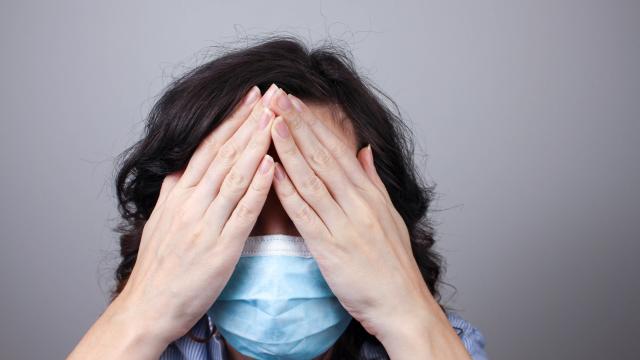Have you noticed your eyes feeling especially dry lately? There could be a variety of reasons for that, including wearing a face mask. But before we go any further, let us be clear: having dry eye is not an excuse to stop wearing a face mask in situations that require them. This is especially the case because there are ways to deal with this. And that’s what we’re here today to talk about: how to treat face mask-related dry eye. Here’s what you need to know.
[referenced id=”930349″ url=”https://www.lifehacker.com.au/2020/06/put-your-mask-over-your-damn-nose/” thumb=”https://www.gizmodo.com.au/wp-content/uploads/sites/4/2020/05/coronarestrictions-300×169.jpg” title=”Put Your Mask Over Your Damn Nose” excerpt=”We know that you should be wearing some form of face covering to prevent the spread of the coronavirus. You just should. Don’t argue with me on this.”]
Why can face masks make your eyes dry?
Given that face masks cover the nose and mouth, how are they managing to affect our eyes? Well, the researchers at the Centre for Ocular Research & Education (CORE) at the University of Waterloo in Canada have been looking into this for several months, and have dubbed it mask-associated dry eye (MADE). We’ll let them describe what MADE is and why it happens:
Masks significantly reduce the outward spread of air. However, exhaled air still needs to disperse; when a mask sits loosely against the face the likely route is upwards. This forces a stream of air over the surface of the eye, creating conditions that accelerate tear film evaporation, leading to dry spots on the ocular surface and discomfort.
In addition to worsening symptoms in patients with pre-existing dry eye disease, MADE can affect a wide-spectrum of others: the elderly who typically have a poorer quality tear film, contact lens wearers, and masked people working extended hours in air-conditioned settings and/or while using digital screens.
Beyond discomfort, MADE may encourage people to rub their eyes for temporary relief — raising the possibility of unwashed hands being brought to the face. In turn, this increases the likelihood of coronavirus infection through the mouth, nose, and to a lesser extent, the eye.
How can we treat dry eye caused by masks?
According to the professionals at CORE, if you’re experiencing dry eye (especially if it’s something new), you’re going to want to talk to a trained medical professional to rule out any other possible causes. Otherwise, here are their tips for dealing with MADE:
- Make sure that you’re wearing your mask correctly, especially if you wear glasses or sunglasses. CORE suggests carefully taping the top edge of the mask in a way that doesn’t interfere with blinking.
- Use lubricating eye drops if you need them.
- Try to limit the time you spend in air-conditioned environments and take regular breaks from digital devices.
Technically, that’s pretty solid advice (and common sense), but having a bottle of eye drops handy and paying attention to the fit of your mask can make a difference here.

Leave a Reply
You must be logged in to post a comment.